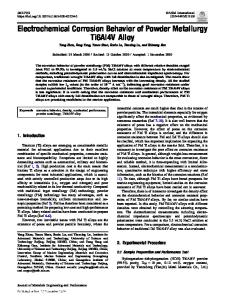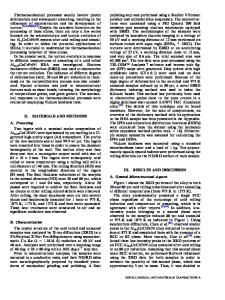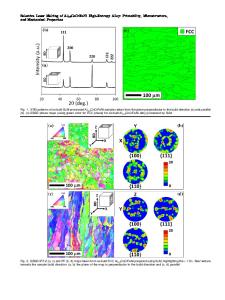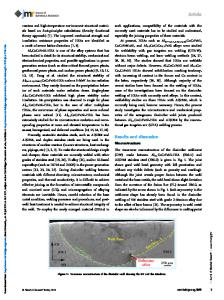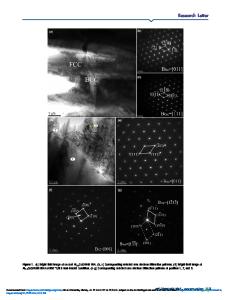Powder metallurgy of Al 0.1 CoCrFeNi high-entropy alloy
- PDF / 1,592,184 Bytes
- 13 Pages / 584.957 x 782.986 pts Page_size
- 51 Downloads / 316 Views
Powder metallurgy of Al0.1CoCrFeNi high-entropy alloy Rathinavelu Sokkalingam1, Marek Tarraste2, Kumar Babu Surreddi3, Valdek Mikli4, Veerappan Muthupandi1, Katakam Sivaprasad1,a), Konda Gokuldoss Prashanth2,5,6,b) 1 Advanced Materials Processing Laboratory, Department of Metallurgical and Materials Engineering, National Institute of Technology, Tiruchirappalli 620015, Tamil Nadu, India 2 Department of Mechanical and Industrial Engineering, Tallinn University of Technology, 19086 Tallinn, Estonia 3 Materials Technology, Dalarna University, SE-791 88 Falun, Sweden 4 Department of Materials and Environmental Technology, Tallinn University of Technology, 19086 Tallinn, Estonia 5 Erich Schmid Institute of Materials Science, Austrian Academy of Sciences, Leoben A-8700, Austria 6 CBCMT, School of Mechanical Engineering, Vellore Institute of Technology, Vellore 632014, India a)Address all correspondence to these authors. e-mail: [email protected] b)e-mail: [email protected]
Received: 30 April 2020; accepted: 9 September 2020
Al0.1CoCrFeNi high-entropy alloy (HEA) was synthesized successfully from elemental powders by mechanical alloying (MA) and subsequent consolidation by spark plasma sintering (SPS). The alloying behavior, microstructure, and mechanical properties of the HEA were assessed using X-ray diffraction, electron microscope, hardness, and compression tests. MA of the elemental powders for 8 h has resulted in a two-phased microstructure: α-fcc and β-bcc phases. On the other hand, the consolidated bulk Al0.1CoCrFeNi-HEA sample reveals the presence of α-fcc and Cr23C6 phases. The metastable β-bcc transforms into a stable α-fcc during the SPS process due to the supply of thermal energy. The hardness of the consolidated bulk HEA samples is found to be 370 ± 50 HV0.5, and the yield and ultimate compressive strengths are found to be 1420 and 1600 MPa, respectively. Such high strength in the Al0.1CoCrFeNi HEA is attributed to the grain refinement strengthening.
Introduction The high-entropy alloy (HEA) concept is an innovative alloy design strategy, where multiple principal alloying elements are added (mostly in equiatomic proportions) to yield a singlephased microstructure [either face-centered-cubic ( fcc) or body-centered-cubic (bcc)] [1, 2, 3]. Traditionally, the alloys contain a base principal element with minor alloying elements (mostly follow Hume–Rothery Rules) to achieve desired properties depending on their applications. It was strongly believed that alloying of more than one principal element could lead to the formation of intermetallic or complex structures or bulk metallic glasses [4, 5]. In 2004, Cantor and Yeh came up with new alloys, where multiple principle elements in equimolar fraction (CoCrFeMnNi and AlCoCrCuFeNi alloys) had resulted in a simple crystal structure [6, 7]. According to Yeh et al., the simple crystal structure attained in the HEA is attributed to the high configurational entropy of the system [6]. Further, HEAs exhibit superior mechanical properties, corrosion, oxidation, and irradia
Data Loading...


